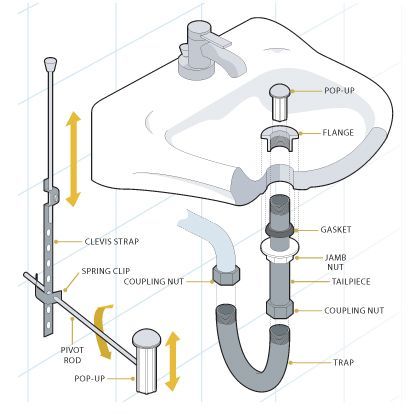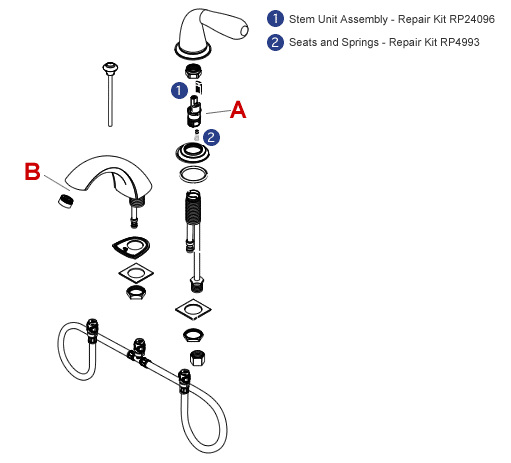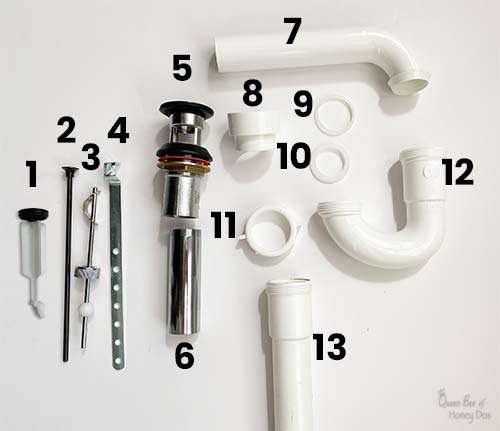Understanding the Common Bathroom Sink Repair Parts
Bathroom sink repair can seem daunting, but with the right knowledge and tools, it can be a manageable task. Understanding the common bathroom sink repair parts is essential for successfully fixing any issues that may arise. Below we provide a comprehensive guide to help you navigate the world of bathroom sink repair parts.
- Faucet Repair Parts: The faucet is one of the most crucial components of a bathroom sink. It can develop leaks or become worn over time. Common faucet repair parts include cartridge valves, O-rings, washers, and aerators. Knowing how to identify and replace these parts can help you fix faucet-related issues efficiently.
- Drain Assembly Parts: A clogged or faulty drain can cause water to back up in the sink. To address this issue, you may need to replace drain assembly parts such as the pop-up stopper, drain flange, or drain pipe. Understanding the purpose of each part and how they work together will enable you to troubleshoot and repair drain-related problems effectively.
- Sink Bowl Parts: The sink bowl itself may require repair if it becomes cracked or chipped. In such cases, you may need to replace the entire sink bowl or opt for a repair kit specifically designed for ceramic or porcelain sinks. Understanding the types of sink bowl parts available and when to repair or replace them will help you maintain the functionality and aesthetics of your bathroom sink.
- Supply Line Parts: Supply lines are responsible for delivering water to the faucet from the main water supply. Over time, they may deteriorate or develop leaks. Common supply line repair parts include flexible hoses, shut-off valves, and compression fittings. Familiarizing yourself with these parts will allow you to address any supply line issues promptly.
- Miscellaneous Repair Parts: In addition to the major components mentioned above, several miscellaneous repair parts may be necessary for specific bathroom sink repairs. These can include gaskets, seals, mounting hardware, and overflow covers. Having a basic understanding of these parts will ensure that you have the necessary tools to tackle a wide range of bathroom sink repair projects.
Essential Bathroom Sink Repair Parts
When it comes to bathroom sink repairs, having the essential repair parts on hand is crucial. Being prepared with the right tools and components can save you time and effort when tackling common sink issues. Let’s discuss the essential bathroom sink repair parts that every homeowner should have in their toolkit.
Plunger: A plunger is a versatile tool that can help unclog a blocked sink drain. It creates suction, which helps dislodge debris and clear minor clogs. Having a plunger on hand is essential for any bathroom sink repair kit. Make sure to choose a plunger specifically designed for sinks to ensure a proper seal.
Adjustable Wrench: An adjustable wrench is a must-have tool for any plumbing repair. It allows you to tighten or loosen various fittings, such as supply line connections and faucet nuts. Choose an adjustable wrench with a comfortable grip and ensure it can accommodate different sizes of nuts and bolts.
Pipe Wrench: A pipe wrench is a heavy-duty tool designed for gripping and turning pipes. It is essential for removing stubborn fittings, such as the drain pipe or supply line connections. Opt for a pipe wrench with adjustable jaws to accommodate different pipe sizes. Remember to use caution when using a pipe wrench to avoid damaging the sink or pipes.
Replacement Washers and O-rings: Leaky faucets are a common bathroom sink issue, often caused by worn-out washers or O-rings. Having a set of replacement washers and O-rings is essential for quick and easy faucet repairs. Ensure you choose the correct size and material for your specific faucet model.
Pipe Tape: Pipe tape, also known as plumber’s tape or Teflon tape, is a thin, flexible tape used to create a watertight seal on threaded pipe connections. It is essential for preventing leaks in fittings such as supply lines or drain pipes. Wrap the tape clockwise around the threads before reconnecting the fittings for a secure seal.
Silicone Caulk: Silicone caulk is a waterproof sealant used to fill gaps and create a watertight seal around the sink bowl or faucet base. It is crucial for preventing water damage and maintaining the integrity of your bathroom sink. Choose a high-quality silicone caulk that is specifically formulated for bathroom use.
Troubleshooting Bathroom Sink Issues
Experiencing issues with your bathroom sink can be frustrating, but identifying the right repair parts is the first step in resolving the problem. By troubleshooting the issue and understanding which components are causing the malfunction, you can save time and money by purchasing the correct repair parts. We will guide you through troubleshooting common bathroom sink issues and help you identify the right repair parts for each problem.
Leaky Faucet: A leaky faucet is a common issue that can waste water and increase your utility bills. To troubleshoot a leaky faucet, start by identifying the source of the leak. It could be a worn-out washer, O-ring, or cartridge valve. Once you’ve identified the problematic part, you can purchase the corresponding repair part to fix the issue.
Slow Draining Sink: If your bathroom sink is draining slowly, there may be a clog in the drain assembly. Start by removing the pop-up stopper and inspect it for any debris or hair that may be causing the blockage. If the stopper is clear, the clog may be further down the drain pipe. In this case, you may need to purchase drain cleaning tools such as a drain snake or chemical drain cleaner.
Cracked or Chipped Sink Bowl: A cracked or chipped sink bowl not only affects the aesthetics of your bathroom but can also lead to water damage. If you notice any cracks or chips, you may need to replace the entire sink bowl or use a repair kit specifically designed for ceramic or porcelain sinks. Take accurate measurements of your sink bowl before purchasing a replacement or repair kit to ensure a proper fit.
Noisy Faucet: A noisy faucet can be irritating and may indicate a problem with the aerator or cartridge valve. Start by cleaning the aerator to remove any mineral deposits that may be causing the noise. If the noise persists, you may need to replace the cartridge valve. Consult the manufacturer’s instructions or a professional plumber to ensure you purchase the correct replacement part.
Loose or Wobbly Faucet: A loose or wobbly faucet can be a nuisance and may indicate loose mounting hardware or worn-out O-rings. Start by tightening the mounting nuts underneath the sink. If the faucet continues to wobble, you may need to replace the O-rings or other worn-out components. Consult the manufacturer’s instructions or seek professional help to identify the correct repair parts.
DIY Bathroom Sink Repair
Taking on a DIY bathroom sink repair can save you money and give you a sense of accomplishment. With the right tools, knowledge, and repair parts, you can tackle common sink issues with confidence. Follow this step-by-step guide to help you navigate the process of DIY bathroom sink repair, along with recommended repair parts for each task.
Fixing a Leaky Faucet:
- Step 1: Turn off the water supply to the sink.
- Step 2: Remove the faucet handle using a screwdriver or Allen wrench.
- Step 3: Inspect the cartridge valve, washer, and O-ring for any signs of wear or damage.
- Step 4: Replace the worn-out parts with the recommended repair parts.
- Step 5: Reassemble the faucet handle and turn on the water supply to test for leaks.
Recommended repair parts: Cartridge valve, washer, O-ring.
Clearing a Clogged Drain:
- Step 1: Remove the pop-up stopper or drain plug from the sink.
- Step 2: Use a plunger to create suction and dislodge the clog.
- Step 3: If the plunger doesn’t work, use a drain snake or chemical drain cleaner to clear the clog.
- Step 4: Reassemble the pop-up stopper or drain plug and run water to ensure the drain is clear.
Recommended repair parts: None (unless there is a need to replace the pop-up stopper or drain assembly parts).
Repairing a Cracked Sink Bowl:
- Step 1: Clean and dry the cracked area of the sink bowl.
- Step 2: Apply a porcelain or ceramic repair kit specifically designed for sink repairs.
- Step 3: Follow the manufacturer’s instructions to fill and seal the crack.
- Step 4: Allow the repair to dry and cure according to the manufacturer’s recommendations.
- Step 5: Sand and polish the repaired area for a smooth finish.
Recommended repair parts: Porcelain or ceramic repair kit.
Tightening a Loose Faucet:
- Step 1: Turn off the water supply to the sink
- Step 2: Use an adjustable wrench to tighten the mounting nuts underneath the sink.
- Step 3: If the faucet continues to wobble, remove the faucet handle and inspect the O-rings for any signs of wear.
- Step 4: Replace the worn-out O-rings with the recommended repair parts.
- Step 5: Reassemble the faucet handle and turn on the water supply to ensure stability.
Recommended repair parts: O-rings.
Replacing a Broken Supply Line:
- Step 1: Turn off the water supply to the sink.
- Step 2: Use an adjustable wrench to disconnect the old supply line from the shut-off valve and faucet.
- Step 3: Measure the length of the old supply line to ensure the new one is the correct size.
- Step 4: Install the new supply line, ensuring a secure connection at both ends.
- Step 5: Turn on the water supply and check for any leaks.
Recommended repair parts: Flexible hose, shut-off valve, compression fittings.
Choosing the Right Bathroom Sink Repair Parts
Choosing the right bathroom sink repair parts is essential for a successful repair. With so many options available, it can be overwhelming to determine which parts are best suited for your specific sink and repair needs. Let’s discuss the factors you should consider when selecting bathroom sink repair parts, ensuring that you make the right choices for a successful repair.
Compatibility: When choosing repair parts, it is crucial to ensure compatibility with your specific sink model. Different sinks may have unique specifications and requirements. Consult the manufacturer’s instructions or seek professional advice to identify the correct repair parts for your sink. Using incompatible parts can lead to further damage and may not solve the underlying issue.
Quality: Opting for high-quality repair parts is essential for a long-lasting and durable repair. Invest in reputable brands known for their reliability and longevity. Quality repair parts are less likely to fail or cause further problems in the future. Read customer reviews, seek recommendations, and choose repair parts that are known for their quality.
Materials: Consider the materials used in the repair parts. For example, choose corrosion-resistant materials for faucet repair parts to prevent future issues. Ensure that materials used in drain assembly parts are resistant to rust and can withstand the harsh conditions of a bathroom environment. Selecting the right materials will ensure the longevity and effectiveness of your repair.
Ease of Installation: Consider the ease of installation when choosing repair parts, especially if you plan to tackle the repair yourself. Look for parts that come with clear instructions and are easy to install. Some repair parts may require specialized tools or professional expertise. If you are unsure about the installation process, it is best to seek professional help to ensure a successful repair.
Warranty: Check if the repair parts come with a warranty. A warranty provides peace of mind, as it guarantees that the manufacturer stands behind the quality and performance of their products. Be aware of the warranty terms and conditions, such as the duration and coverage. Opting for repair parts with a warranty can protect you from unforeseen issues and give you added confidence in your repair.
Bathroom Sink Plumbing Diagram DIY
Peerless Bathroom Sink Pop-Up Drain Assembly, Chrome
Troubleshooting a Leaking Faucet : Delta Faucet
How To Install Bathroom Sink Drain u2022 Queen Bee of Honey Dos
Bathroom Sink Plumbing
Moen Bathroom Faucet 4551 eReplacementParts.com
Related Posts:











